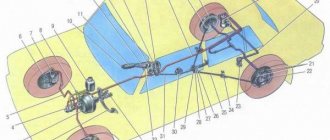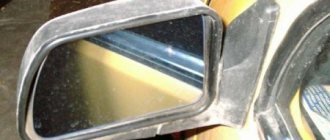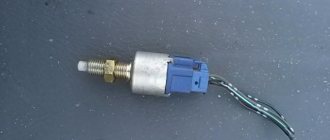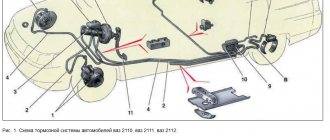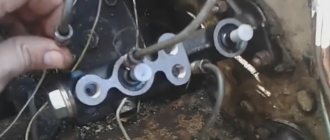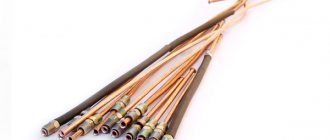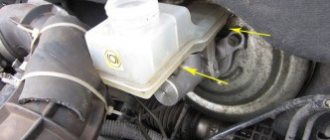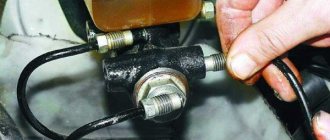The VAZ 2107 is far from a perfect car; it cannot boast of the reliability of its systems. Including brake mechanisms, on which the safety of driving depends. Sometimes situations arise when the system does not work efficiently or there is a brake fluid leak - in such cases, immediate repairs are required. You can do the work yourself, for which you will need to prepare the necessary tools and read the instructions.
- Soft brake pedal
- Stiff pedal
- One wheel does not brake
- Liquid is leaving the reservoir
- Repair of master and working brake cylinders
Video: GTZ repair on a VAZ 2107
- What kind of brake fluid should I fill in the VAZ 2107 and how much?
- Procedure for bleeding the brakes
Video: pumping brakes on a VAZ
Design of the VAZ 2107 brake system
It is necessary to bleed the brake system in four cases:
- Replacing brake fluid. Brake fluid has a limited service life. Over time, it absorbs moisture from the air, which can cause corrosion of the surface of the brake cylinders and their failure. Water also worsens the main property of brake fluid - it reduces the boiling point.
- The recommended service life of brake fluid on VAZ cars is 2 years, after which it is worth replacing it. This applies to standard glycol-based brake fluid.
- Troubleshooting the brake system. When replacing brake hoses and cylinders, brake fluid leaks and air enters the system. Therefore, after repair work, the VAZ 2107 brakes must be bled.
- Air ingress during operation. This manifests itself in deterioration in braking efficiency, a “soft pedal” or uneven braking of individual wheels.
For ease of work and to ensure free access to the brake cylinder fittings, you should use an inspection hole. The design of the front brake mechanisms requires removal of the wheels to bleed the brake system.
Before starting work, it is necessary to fill the brake reservoir to the maximum, and during bleeding, you must ensure that it is constantly filled with brake fluid. If you miss this moment, air will get into the working cylinder and you will have to start work again.
The procedure for each of the 4 working cylinders is as follows:
- Remove the protective cap from the fitting.
- Loosen the fitting using a spanner. If the fitting has not been unscrewed for a long time, significant effort may be required. You must be especially careful not to damage the edges, otherwise the work may become very difficult, even to the point that the brake cylinder will need to be replaced.
- Place the tube on the fitting and lower it into the brake fluid container.
Direct pumping is performed as follows:
- The “partner” sitting in the cabin, at the command of the “mechanic”, presses the pedal all the way.
- The “mechanic” unscrews the fitting half a turn so that the liquid, along with air bubbles, comes out into the container through the inserted tube. The brake pedal “sinks” to the floor.
- The “fitter” tightens the fitting, and the “partner” releases the pedal on command.
The procedure is repeated until no more air bubbles come out of the tube. During bleeding, the end of the tube must be constantly lowered into the brake fluid so that air does not enter the cylinder.
In this way, all four working brake cylinders are pumped. A certain sequence should be followed when bleeding the cylinders. They are pumped “from far to near”:
- Right rear.
- Left back.
- Right front.
- Left front.
After completing bleeding of each cylinder, it is necessary to tighten the fitting and put on the protective cap.
Bleeding the brakes of a VAZ 2107 is quite feasible at home and does not require expensive special tools and devices. No special qualifications are required either. Even a child can release and press the brake pedal at the “locksmith’s” command.
Often, owners upgrade the brake system by installing more efficient, high-quality and expensive parts. However, this does not change the bleeding method in any way and does not eliminate the need for periodic work to replace the brake fluid.
The design of the VAZ 2107 brakes takes us back to the times when the city of Tolyatti was a wasteland, the whole country drove Muscovites and Volgas with drum brakes, and only read about disc brakes in the “Their Morals” section of the Za Rulem magazine. Capitalists have been riding on luxurious cooled and ventilated disc brakes since the 30s, but this design innovation reached us only in the second half of the 60s, and then at the instigation of Fiat.
The hydraulic drive system of the domestic 2107 model uses DOT-4 brake fluid. Content volume – 382 ml. It is not necessary to change or add fluid during repairs. It may be needed if moisture gets in or changes color. Mostly on Zhiguli cars a complete fluid change is required every 3 years. The process itself comes down to pumping liquid through the system.
Let's answer some frequently asked questions
Is it possible to bleed the front or rear brakes separately on a classic?
Can. Moreover, you can separately swing the left and right mechanisms of one axis. The rear and front contours are not connected to each other if the entire cuffs are in the GTZ. Therefore, the risk of airing your neighbor is minimal. Agree, when replacing the front brake cylinder, only it is pumped, not the entire system. This also applies to the rear wheels. Repeatedly, when changing the rear cylinder on classic Zhiguli cars, I only pumped it. After this, all mechanisms continued to work properly.
Why don't the brakes bleed?
It often happens that after much torment the pedal remains “sluggish” and has little information.
- If the system or individual element is not sealed. They just didn't notice the leak. When you press the brake, some of the pressure is released into the hole, rather than going into the cylinders, and air may occur.
- When replacing the brake master cylinder. If you do not release the air from its chambers, it is difficult to squeeze it through the narrow passages of the tubes to the bleeder fittings. There is no guarantee that it will come out completely. How to do this correctly was explained at the beginning of the article.
Soft and stiff brake pedal
The normal position of the brake pedal of the 2107 model is when there are no jerks or dips when pressed, and no effort is required. At the same time, during the operation of the car, car owners are sometimes faced with the fact that the brake pedal manifests itself in a completely different way, that is, it becomes too tight or soft.
Such manifestations are unacceptable and indicate problems in the braking system. Therefore, prompt repairs are required. Often the pedal becomes soft when the system is too airy. This phenomenon is also called failure. The damage can be repaired by bleeding the brakes, that is, it is necessary to remove accumulated air from the system. The latter could have happened due to the following reasons:
- not enough fuel fluid in the expansion tank;
- sealing in the braking system is broken;
- damage to the brake cylinder.
At the same time, there is a situation where when pressing the pedal it requires excessive force, for which the vacuum booster (VA) is to blame. This mechanism creates a vacuum in the manifold (intake). The fact that the pedal is tight is indicated by a number of reasons:
- the VU air filter is clogged, therefore, it needs to be replaced;
- the VU valve body is jammed; the vacuum booster should be replaced;
- the VU diaphragm is damaged; replacement of the control unit is required;
- wear of the tip of the device; the tip needs to be replaced;
- incorrect operation of the check valve in the control unit; it is worth replacing;
- the seal is broken; the VU or check valve should be replaced;
- damage to the hose connecting the intake manifold and the intake manifold, or the tightening of the clamp in it is loose;
- increasing the size of cuff cylinders in brake cylinders; this happens when using poor quality fuel fluid.
Bleeding brakes on VAZ 2101-VAZ 2107
Welcome! Bleeding the brakes is one of the main necessary procedures after replacing or removing any cylinders or hoses of the brake system.
This procedure, as you already understood, is necessary, otherwise if air gets into the hydraulic brake drive after disconnecting any hoses or anything else, then in this case the wheel on which you replaced the brake hose will simply not brake, since in the system there will be air that simply won’t allow you to do this, but more on that a little later, but now let’s look at some issues and find out how you generally need to bleed the brake system on a classic car. Note! To bleed the brakes you will need to use: A basic set of wrenches, as well as a small bottle (About 0.5 liters) inside of which there will be some new brake fluid and you will also need to take with you a short hose, one end of which you will put on the bleeder fitting, and the other end of which you will put into a bottle of new brake fluid (You will understand in more detail why this hose is needed by reading this article in full)!
Summary:
What is used to bleed the brakes? It is done through bleeder fittings that are installed on the brake assemblies of all wheels of your car, for example, on the front wheels the bleeder fitting is located on the brake caliper itself; for more details on the location of the bleeder fitting, see the photo shown just below:
Note! In this photo from above, there is a plastic cap on the bleeder fitting, so the fitting itself is not clearly visible there, but only the cap that covers it is visible, but still the location of the fitting itself on the brake caliper can be approximately understood!
Why do you need to bleed your brakes and when should you do it? Over time, air gets into the hydraulic brake drive and thus the car begins to brake much worse, and therefore the risk of getting into a car accident increases, so to prevent this from happening, you need to pump the brakes on the car from time to time.
Air, as a rule, can get into the system for several reasons, namely, if your brake fluid has not been replaced for a long time, for example, about 3 years, then this indicates that it needs to be replaced (Do not bleed) and quickly, since it will soon be In total, moisture has penetrated during this entire time, thereby it will boil faster during intense braking and the effectiveness of the brakes may decrease. (For information on how to replace brake fluid, see the article: “Replacing brake fluid on a VAZ”)
But still, let’s return to our topic about bleeding, namely, the hydraulic brake drive needs to be pumped if you have replaced or simply removed any parts of the brake system, for example, after replacing the brake fluid, the hydraulic brake drive will need to be pumped, and so same after removing one of the brake system cylinders, when removing a brake hose, etc.
Note! By the way, to understand that air penetrated into the brake system very easily, just press the brake pedal several times, if at the first presses it is very light and then gradually begins to become hard, then this will indicate that you have air in the hydraulic brake drive will need to be completely removed from the system!
Dual-circuit braking system
True, this did not affect the maintenance of the brake system in any way. It was reliable and indestructible, and remained with the amplifier. And it worked great, except when the diaphragm wore out. The dual-circuit braking system was new for the domestic car enthusiast. Although the Muscovites 408 of the first years of production were produced with hydraulics, they still had antediluvian drum brakes, and, like on the GAZ 53, there was only one circuit.
This means that if any of the wheel working cylinders were damaged, the entire system would fail and become depressurized. VAZ cars were initially free from this drawback, since the brakes were divided into two circuits - front and rear. Therefore, if one of the wheels leaked, at least two could still brake. This is not much, but it affected the process of pumping the brakes, which we will talk about in more detail today.
How to properly bleed the brakes on a VAZ 2101-VAZ 2107?
Note! Before we begin, let’s say a few words, namely, in classic cars, the braking system is divided into two circuits, in which both front wheels are the first circuit, and both rear wheels are the second circuit, so if you have air in any of the circuits, then you need will bleed this particular circuit and it is not necessary to bleed the second one, it will simply be pointless, let's give an example, let's say you replaced the brake caliper on the right front wheel, when replacing you had to disconnect the brake hose from it (the hose must be disconnected, without disconnecting it you have nothing won’t work), so when you installed a new caliper in place of the old one, you first need to bleed the brakes, and why bother with the rear circuit if you only had the front one depressurized, then you will need to bleed exactly the two front wheels and this will get rid of from air in the system!
If suddenly you have a depressurization of the first and also the second circuit, for example, you replaced the brake hoses on one of the front wheels and on one of the rear wheels, then in this case you will need to remove air from both circuits, that is, the two front wheels and immediately two back ones!
And one more thing, it’s most convenient to pump with an assistant, since if you are just one, it will be inconvenient without a special tool, but it can still be done, but as was said earlier, for this you will need to stock up on a special tool! (You can see more details about how to bleed the brakes alone at the very end of this article in an interesting video clip)
Bleeding: 1) At the very beginning of the operation, figure out which wheel you will bleed, if any of the front ones then you will need to remove this wheel from the car (do not apply to the rear ones), since on the front wheels the bleeder fitting is very inconveniently located and in order to get to it, you will need to remove the wheel. (For information on how to remove a wheel from a car, see the article: “Replacing a wheel on a VAZ”)
Bleeding the brakes: step-by-step instructions
To better pump the brakes of the “Seven” you will need an assistant. One will be under the car and work on the brake cylinders, while the other presses the brake pedal inside the car. The following tools will be useful in your work:
- head for 8 and 10 caps;
- head for 8 and 10, open-end or for brake pipes;
- transparent container for waste;
- hose of the required diameter.
Pumping starts from the furthest tire from the GTZ, therefore, start from:
- right rear tire;
- left rear;
- right front;
- left front.
To bleed the rear tire brakes, go under the car. All work related to the front brakes is carried out after the tires have been removed in advance. Otherwise the procedure is identical:
- Remove the protective cap from the brake cylinder fitting. Loosen the fitting slightly with an 8 and 10 mm wrench.
- Connect the hose to the fitting and place the opposite end into a container.
- Press the brake pedal until hardness appears and keep it pressed.
- Unscrew the fitting half a turn. The fuel fluid will begin to flow out of the hose, the pedal is pressed to the floor. Do not release the pedal until the liquid stops oozing.
- Tighten the fitting and repeat the process until liquid and air come out of the tube.
- Repeat the manipulations with the remaining tires of the VAZ-2107. To bleed the front brake, simply remove the wheel.
- To complete the pumping, close the fitting with a rubber cap. During pumping, you should monitor the fluid level in the expansion tank. It is important that there is no air in the system.
Which wheel to start with?
Let's start the conversation with the sequence, and then move on to a description of the process. You know that the brake system of the VAZ 2107 and other domestic classics has two circuits, or more precisely, three. The first is the front wheels, it consists of two separate lines, it is customary to combine it into one circuit of the front brake mechanisms. The second is the rear wheels. From the main brake cylinder there is one brake pipe going to the “stern” of the car, which is divided into each side of the rear axle. Based on the design, you need to start pumping from the farthest element of the system - the right rear wheel.
Important! Each circuit swings separately, from the beginning we deal exclusively with one, let’s say the rear one, then we move on to the front. If the sequence is violated, problems may arise in the adequacy of the brakes.
Having released the air from the right rear mechanism, we move on to the left rear one. Having finished with it, we move on to the right front, and then to the left front. We start pumping from the farthest section from the GTZ (it is located under the hood on the left side) - this is the rear contour, the right side, then the left, then the farthest section of the front contour - the right side, then the left.
If you replaced the master cylinder, you first need to bleed the air from it
- Fill the brake fluid into the reservoir
- We “fit” the fittings of the brake pipes into the outlet holes of the cylinder. Don't tighten them, just wind them a couple of turns. This is necessary so that air can freely escape from the junction of the tubes and the GTZ housing
- When pouring brake fluid into the reservoir, it can flow out of the fittings by gravity. Otherwise, ask an assistant to press the brake pedal several times. The liquid will not emit a fountain from loosely twisted tubes. First, air will come out, you will see characteristic bubbles, then the liquid itself will begin to ooze.
- Make sure all connections are leaking evenly. Only after this do we tighten the fittings of the lines and wipe these places with a dry cloth
Video on how to bleed the master brake cylinder or why the system is not bleeding:
Brake bleeding devices
The plant officially recognized only one method of bleeding the brakes - the one described in the user manual. But inventive car enthusiasts found more and more new options for how to bleed the brakes on a VAZ 2107. In principle, two people needed to bleed the brakes. According to the old habit, when the line systems were unreliable, the brake cylinders were bulky and bulky. In the seven, it was possible to completely replace the brake fluid in 15 minutes, without any difficulties, even alone.
Why in this order?
Who the hell knows! All experts claim that it is necessary to pump the brakes on sevens in exactly this sequence, but no one gives a logical explanation. If you know, write in the comments, it’s interesting to discuss this topic.
Why start with the rear wheels? - because they are the farthest, you answer. Okay, but the contours of the rear and front are separated from each other by the piston cuffs of the master brake cylinder! The front circuit starts working first in case of braking, why not pump it first?
I will express my theory based on experience and observations. Since the second chamber of the master cylinder is responsible for the rear brakes, the last one along the piston stroke, it means that after pumping it, it will be easier to pump the first one. If you do the opposite, then it will be problematic to completely “expel” the air from the rear brake circuit. When pressing the brake pedal, the piston will compress the fluid in the first chamber, and you will not be able to feel with your foot the degree of elasticity of the pedal after pumping. There is a chance that not all the air will escape and the rear axle will not brake.
But in the family of front-wheel drive VAZs, the order is different, cross to cross. The chamber closest to the vacuum amplifier is pumped first, that is, vice versa. We will talk about this in detail in other articles.
How much and what kind of brake fluid should be poured into the VAZ-2107
Fluid replacement should be carried out according to the maintenance schedule. Any brake fluid contains a large number of additives that evaporate over time. The operating mode of the system is very complex, high temperature and pressure make themselves felt. All additives that affect the metal and rubber elements of the system evaporate.
Therefore, it is recommended to completely replace the fluid every 80-100 thousand kilometers. This is the maximum service life of additives that are present in brake fluids. Accordingly, you need to carry out bleeding during a complete replacement.
What if without an assistant?
You can bleed the brakes on a VAZ-2107 without an assistant, but to do this you will have to slightly modify the design of the expansion tank cap. You need to buy a new cover into which you install the fitting from a regular camera. Now you need to create pressure in the system - this can be done using a camera or tubeless wheel. Inflate using a compressor and do the following:
- Fill the expansion tank with brake fluid.
- Install a cover with a fitting on it.
- Connect the fitting on the cover and the chamber using a tube.
- In this case, there is no need to install spool valves inside - they will be superfluous.
- Carry out repairs following the brake bleeding sequence described above.
Do not forget to add fluid to the system, otherwise an air lock will appear in it. You will have to bleed the brakes again. The VAZ-2107 uses the brand of fluid “RosDot-3” or “RosDot-4”. Try to use only those fluids recommended by the manufacturer.
Bleeding the brakes of a VAZ 2107 requires that an assistant sits behind the wheel and, at the command of the mechanic who performed the replacement, responds to shouts of “pump!” actively pumping up pressure in the system to expel air from it. "Hold it!" - meant that the mechanic unscrewed the fitting and the air, along with the old fluid, came out through the tube. The pedal had to be at the very bottom before the “Start!” command was received. In this case, among the special devices for pumping it was necessary to have:
- container for pumping and draining old fluid;
- a nylon tube with such a diameter that it fits flush onto the fitting;
- a spanner for bleeding, so that it is convenient to unscrew the fitting;
- a tube tip (optional), which worked as a check valve and was taken from the washer reservoir.
Later, even on sale, in the heyday of cooperative trade, special caps for the brake fluid reservoir, in which a nipple from a tubeless tire was embedded. Hit of the late 80s. We'll tell you how to use it right now.
What is needed to bleed the system
In order to bleed the brakes on a VAZ-2107, you need to acquire a set of tools. First of all, you need to decide where you will carry out the repairs. It is best to do it on a pit, overpass or lift. On a flat surface it is possible, but it will be somewhat more difficult. Therefore, it is recommended to find an overpass.
You will need the following set of tools:
- Wrenches for “8” and “10”.
- Special "8" wrench for brake pipes.
- A jack may be needed.
- The container is transparent, about 0.5 liters in volume.
- Flexible transparent hose.
- Liquid for filling.
Before changing the fluid, you need to completely check the braking system and replace worn components if necessary.
Brake hoses: replacement
If the car owner notices smudges resulting from tire wear, it is necessary to change the brake hoses. Technical literature says that hoses installed more than 3 years ago are prohibited from being used. The explanation for this is simple: firstly, rubber ages, and secondly, it is more susceptible to deformation.
In a VAZ-2107 car, brake hoses are located both at the front and at the rear. These components lead the fluid fluid to the working cylinders. Having found out that the rubber component requires replacement, you need to stock up on:
- screwdrivers;
- pliers;
- a set of keys;
- new hose;
- brake fluid.
- Remove the front tire from the desired side so that there is convenient access to the caliper.
- Unscrew the bolt securing the hose from the reverse side and remove it with copper washers.
- Unscrew the hose in the area of fixation to the brake pipe.
Brake bleeding valve
And the brakes were pumped with the help of this device in splendid isolation, without any assistants, and it was possible to pump the brakes better and faster. Together, of course, it’s more fun, but if time is of the essence, then a bleeding valve was used. The process of pumping brakes on a VAZ 2107 looks like this:
- The maximum amount of fluid is added to the brake fluid reservoir.
- Using a car pump, excess pressure is pumped into the system.
- A container for old fluid is installed under the rear right wheel.
- The tube is put on the fitting and one end is lowered into the container.
- The fitting is unscrewed and the liquid under pressure leaves the system on its own.
- If necessary, the operation is performed for all other wheels.
The only thing that was important was to monitor the fluid level in the tank. It should not fall below the minimum. This way you can bleed the brakes of a VAZ 2107 car alone. Change the brake fluid on time, good luck to everyone and smooth braking!
When should you bleed your brakes?
The need for pumping arises in the following cases:
- The brake master cylinder was repaired.
- The brake pipes were replaced.
- Brake hoses were changed.
- The front brake calipers or rear cylinders were repaired or replaced.
- Scheduled replacement of brake fluid in the system.
When bleeding the brakes on a VAZ-2107, it is necessary to follow a sequence of actions so that subsequently the efficiency of the system is maximized.
All the reasons why pumping is carried out can be called both planned and unplanned. Elements can be replaced both in case of breakdown and when the maximum service life is reached. As for the last point, it is worth talking about separately.
